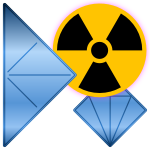Radiation - It's Everywhere
Yes. Radiation is everywhere. It's going through you right now. It's coming out of you right now. But what is it?
At the most basic level, radiation is how stuff exchanges or gets rid of energy, usually by throwing or radiating a particle to carry that energy away. We tend to broadly categorize it in terms of ionizing or non-ionizing.
Ionizing radiation has enough energy to knock electrons out of atoms and break chemical bonds and includes the types of radiation we normally associate with radioactivity. Non-ionizing radiation, on the other hand, does not have enough energy to knock electrons out of atoms and at most will cause atoms and molecules to wiggle a bit more if it's able to interact at all.
The vast majority of radiation that we experience in our day to day life is electromagnetic which comes in the form of elementry particles we call photons with some amount of energy. The amount of energy a photon carries determines how and how much it interacts with the matter that emits or absorbs it. Depending on how much energy a photon carries, it can be either ionizing or non-ionizing. The most familiar form to us is light but the energy can go from very long wavelength radio with very little energy on up to very high energy gamma rays that, contrary to what certain comic book back stories might tell you, will probably not give you super powers.
Radiation can also come in the form of other particles as well. Most often, you'll hear about radiation types called alpha, beta, or gamma. Alpha particles are helium nuclei consisting of two neutrons and two protons that ar ejected from large unstable atoms. Beta particles are electrons that get ejected from large unstable atoms. Gamma rays are high energy photons sometimes emitted from unstable atoms but can be created through other interactions as well.
Other types of radiation include fast and thermal neutrons, neutrinos, and so-called cosmic rays which can be anything from electrons, fast moving protons, or other particles moving at extremely high speeds. In the case of particle accelerators, we pump large amounts of energy into beams of particles of various types and point them at each other and see what comes out. The beams themselves can be considered radiation, as well as the zoo of particles that come flying out when they collide.
We'll go into more detail about each type and how dangerous or harmless each type can be.
